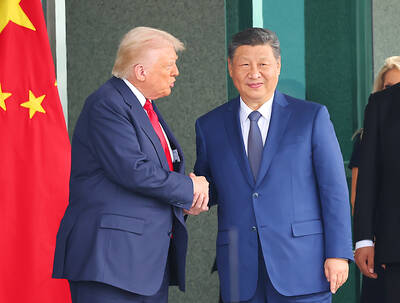China has offered to go on a six-year buying spree to ramp up imports from the US in a move that would reconfigure the relationship between the world’s two largest economies, officials familiar with the negotiations said.
The offer implies raising the annual import total from US$155 billion to about US$200 billion this year and in increasing steps thereafter, reaching an annual total of about US$600 billion by 2024, one of the people said.
By increasing goods imports from the US by a combined value of more than US$1 trillion over that period, China would seek to reduce its trade surplus — which last year stood at US$323 billion — to zero by 2024, one of the people said.
The officials asked not to be named as the discussions are not public.
The offer, made during talks in Beijing earlier this month, was met with skepticism by US negotiators, who nonetheless asked China to do even better, demanding that the imbalance be cleared in the next two years, the people said.
No decisions were finalized in the latest Beijing talks and discussions are to continue at the end of the month, when Chinese Vice Premier Liu He (劉鶴) is to travel to Washington.
US negotiators are focused on matters including China’s alleged intellectual-property malpractices and state support of industry. The major sticking points for the US during the latest round of talks in Beijing were more prominent issues than China’s import plans, one of the people said.
Meanwhile, the US is pushing for regular reviews of China’s progress on pledged trade reforms as a condition for a trade deal — and could again resort to tariffs if it deems Beijing has violated the agreement, according to sources briefed on negotiations to end the trade dispute between the two nations.
A continuing threat of tariffs hanging over commerce between the world’s two largest economies would mean a deal would not end the risk of investing in businesses or assets that have been affected by trade issues.
“The threat of tariffs is not going away, even if there is a deal,” said one of three sources briefed on the talks who spoke on condition of anonymity.
Chinese negotiators were not keen on the idea of regular compliance checks, the source said, but the US proposal “didn’t derail negotiations.”
A Chinese source said that the US wants “periodic assessments,” but it was not clear how often.
“It looks like humiliation, but perhaps the two sides could find a way to save face for the Chinese government,” the source said.
The Chinese Ministry of Commerce did not immediately respond to a request for comment on the negotiation details.
The office of the US Trade Representative did not immediately respond to a request for comment.
White House economic adviser Larry Kudlow on Friday said that the US and China were making progress on trade negotiations, but reaching a deal would take time.
“We’re making progress in negotiating on the grandest scale between the two countries ever, we’re covering everything,” Kudlow told reporters.
“It’s going to take time. We are moving,” he said. “I’d love to make a deal. I’m a free trader but it’s got to be a great deal.”
Additional reporting by Reuters

RUN IT BACK: A succesful first project working with hyperscalers to design chips encouraged MediaTek to start a second project, aiming to hit stride in 2028 MediaTek Inc (聯發科), the world’s biggest smartphone chip supplier, yesterday said it is engaging a second hyperscaler to help design artificial intelligence (AI) accelerators used in data centers following a similar project expected to generate revenue streams soon. The first AI accelerator project is to bring in US$1 billion revenue next year and several billion US dollars more in 2027, MediaTek chief executive officer Rick Tsai (蔡力行) told a virtual investor conference yesterday. The second AI accelerator project is expected to contribute to revenue beginning in 2028, Tsai said. MediaTek yesterday raised its revenue forecast for the global AI accelerator used

Taiwan Semiconductor Manufacturing Co (TSMC, 台積電) has secured three construction permits for its plan to build a state-of-the-art A14 wafer fab in Taichung, and is likely to start construction soon, the Central Taiwan Science Park Bureau said yesterday. Speaking with CNA, Wang Chun-chieh (王俊傑), deputy director general of the science park bureau, said the world’s largest contract chipmaker has received three construction permits — one to build a fab to roll out sophisticated chips, another to build a central utility plant to provide water and electricity for the facility and the other to build three office buildings. With the three permits, TSMC

TEMPORARY TRUCE: China has made concessions to ease rare earth trade controls, among others, while Washington holds fire on a 100% tariff on all Chinese goods China is effectively suspending implementation of additional export controls on rare earth metals and terminating investigations targeting US companies in the semiconductor supply chain, the White House announced. The White House on Saturday issued a fact sheet outlining some details of the trade pact agreed to earlier in the week by US President Donald Trump and Chinese President Xi Jinping (習近平) that aimed to ease tensions between the world’s two largest economies. Under the deal, China is to issue general licenses valid for exports of rare earths, gallium, germanium, antimony and graphite “for the benefit of US end users and their suppliers

Dutch chipmaker Nexperia BV’s China unit yesterday said that it had established sufficient inventories of finished goods and works-in-progress, and that its supply chain remained secure and stable after its parent halted wafer supplies. The Dutch company suspended supplies of wafers to its Chinese assembly plant a week ago, calling it “a direct consequence of the local management’s recent failure to comply with the agreed contractual payment terms,” Reuters reported on Friday last week. Its China unit called Nexperia’s suspension “unilateral” and “extremely irresponsible,” adding that the Dutch parent’s claim about contractual payment was “misleading and highly deceptive,” according to a statement